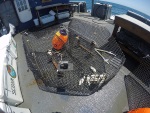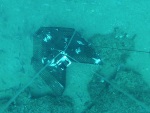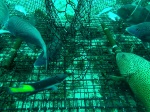Reef Fish Survey (RFS)
Marine Resources Monitoring, Assessment, and Prediction (MARMAP) &
Southeast Area Monitoring and Assessment Program South Atlantic (SEAMAP-SA)
RFS History
Since 1972, the Marine Resources Research Institute (MRRI), through the MARMAP program and SEAMAP-SA, has conducted fisheries-independent research on groundfish, reef fish, ichthyoplankton, and coastal pelagic fishes within the region between Cape Hatteras, North Carolina, and the St. Lucie Inlet area, Florida. The overall mission of the MARMAP and SEAMAP-SA programs have been to determine distribution, relative abundance, and critical habitat of economically and ecologically important fishes in Atlantic waters off the Southeastern United States. Another important aspect of the programs is to relate fish trends to environmental factors and exploitation activities. Research toward fulfilling these goals in the past included trawl surveys (from 6-350 m depth, tagging studies of commercially important species, and ichthyoplankton surveys. Ongoing efforts include locating and mapping of reef habitat, sampling of reefs using traps and longlines, life history and population studies of priority reef fish species, and special studies directed at specific management problems in the region. Current monitoring efforts focus on species associated with hard bottom habitat in the region, in particular on reef fish species managed by the South Atlantic Fishery Management Council's (SAFMC) Snapper-Grouper Fisheries Management Plan (FMP), giving these efforts the nickname "SCDNR Reef Fish Survey" or RFS.
The RFS is a major contributor to a region-wide, collaborative fishery-independent monitoring program known as the Southeast Reef Fish Survey (SERFS). Fishery-independent means that we can collect fish without the same management restrictions on fishers such as seasonal closures, size limits, or catch limits. SERFS field and lab work is conducted by MARMAP, SEAMAP-SA, and the Southeast Fisheries Independent Survey (SEFIS) which is housed at the National Marine Fisheries Service lab in Beaufort, NC. MARMAP was the only participant in region-wide sampling for reef fish from 1990 through 2009. SEAMAP-SA and SEFIS joined in the field sampling in 2010 and continue to collaborate. Data from the RFS and SERFS can be used to determine relative population size for each species encountered each year, which can tell us if population sizes are increasing, decreasing, or staying the same.




